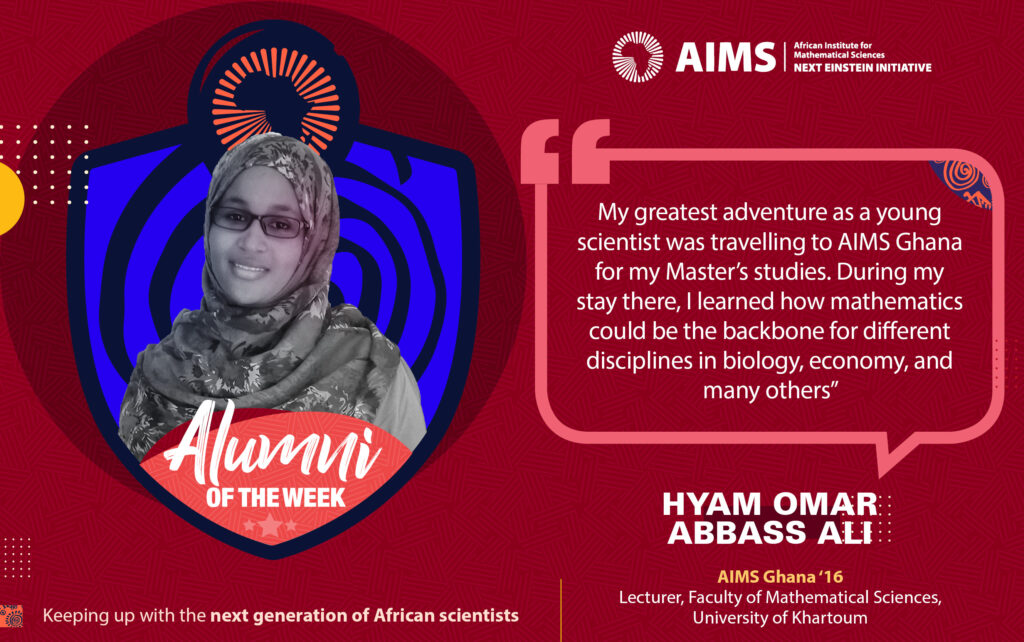We dedicate this edition to celebrating an alumna named among 19 others on the African continent as laureate in the field of Science. The 2021 L’Oréal-UNESCO For Women in Science Young Talent Awards, Sub Saharan Africa, was organised on 25th November 2021 at Kigali. The ceremony awarded 15 doctoral students and five post-doctoral students with an endowment fund of €10,000 and €15,000, respectively, to boost the projects they are embarking on. It is an honour to announce that Hyam Omar Abbass Ali of AIMS Ghana 2016 is one of the awardees.
Hyam is currently a PhD student from Sudan in a joint program between the Mycetoma Research Center (MRC), University of Khartoum, Sudan; INSERM lab, University of Tours, France; and IDP lab, University of Orleans, France. She also works as a full-time lecturer at the University of Khartoum, Faculty of Mathematical Sciences.
She shares that the notice for the Young Talent Award application was first chanced seen on social media but had many details in the Next Einstein Forum (NEF) newsletter shared on a biweekly basis. About the NEF newsletter, this is how she describes it;
“Indeed, the NEF newsletter is one of the most important ones for any scientist. It covers all the highlights, innovations, positions, and many others.”
About the project that won her the award, Hyam and her team looked at making the diagnosis of Mycetoma easier and cheaper using Artificial Intelligence. In this regard, Hyam envisions meeting Sustainable Development Goal 3 — Good Health and Well-Being. She explains the award-winning project:
“Mycetoma is a neglected inflammatory disease that causes severe deformities and disabilities. The therapeutic strategy accurately identifies the causative organism and corresponding classification of the disease as eumycetoma or actinomycetoma. Histopathology is currently the most used diagnostic tool in endemic areas since it is efficient and time-effective though costly. Histopathology diagnosis requires well-trained pathologists. However, these pathologists are mostly not found in rural and endemic areas. In our project, we intend to develop a novel, accurate, and affordable computational diagnostic model which could reduce the need for expert pathologists to perform histology analysis. This is done by investigating mycetoma infection in tissue microscopic images by detecting the presence of grain(s) and determining its causative organism. From microscopic images of Mycetoma infected tissues, our advanced computational method achieved Mycetoma type identification with an accuracy of 91.8%, comparable to the score obtained by experts. Currently, we are aiming to introduce a detection technique to provide an automated segmentation method for grains that will further ease the use of the method to deploy it in local clinical centres. Furthermore, we are working on extending the classification model for the prediction of different causative organisms of eumycetoma and actinomycetoma.”
Without my experience at AIMS, this would not have been possible. “I am very grateful to AIMS”– she says. She goes further to share her experience at AIMS in this manner:
“My greatest adventure as a young scientist was travelling to AIMS Ghana for my Master’s studies. During my stay there, I learned how mathematics could be the backbone for different disciplines in biology, economy, and many others. I understood the significance of networking with scientists from various domains and interests. Investing their knowledge to come out with magnificent ideas and solutions for real-life concerns amazed me. I was honoured to meet brilliant scientists from the African continent with great potentials and mindsets. This is similar to having ambassadors all around Africa who constitute my small regional network. Also, I had a chance to participate in several awareness sessions for secondary school students. We introduced them to the importance of sciences and empowered their eagerness to take a career in Science. This motivated me to focus my effort on sharpening my communications skills and incorporating my mathematical science knowledge with applications directly impacting humans. After returning to Sudan, I operated all of what I learned towards my community through the different activities and projects. While working as a lecturer at a public university, I joined the Mycetoma Research Center (MRC), a WHO collaborating centre, as a research fellow. Later, I started my PhD studies at the MRC.”

